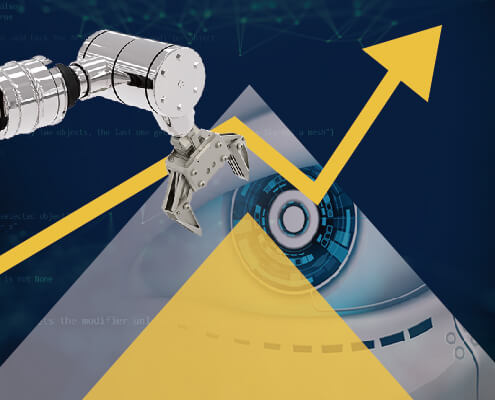Machine Vision Approaching Milestone
Machine vision systems are a staple in production lines for barcode reading, quality control and inventory management. And, as the Industrial Internet of Things (IIoT) continues to expand its reach, these systems have become crucial data collectors.
These solutions often have long replacement cycles and are less prone to disruption. Due to the increasing demands for automation, machine vision is finding its way into new applications Robotics, for example, is a new growth area for machine vision: Collaborative robots rely on machine vision for guidance and object classification, while mobile robots rely on machine vision for SLAM and safety.”
Machine vision is a mature technology with established incumbents. However, significant advancements in chipsets, software, and standards are bringing deep learning innovation into the machine vision sector. According to a recent analysis by ABI Research, total shipments for machine vision sensors and cameras will reach 16.9 million by 2025, creating an installed base of 94 million machine vision systems in industrial manufacturing. Of that installed base, 11% will be deep learning-based.
A different breed from conventional machine vision technology, deep learning-based machine vision is data-driven and utilizes a statistical approach, which allows the machine vision model to improve as more data is gathered for training and testing. Major machine vision vendors have realized the potential of deep learning-based machine learning.
At the same time, chipset vendors are launching new chipsets and software stacks to facilitate the implementation of deep learning-based machine vision. Xilinx, a Field Programmable Gated Array (FPGA) vendor, partnered closely with camera sensor manufacturer Sony and camera vendors such as Framos and IDS Imaging to incorporate its Versal ACAP System on Chip (SoC). Intel, on the other hand, offers OpenVINO for developers to deploy pre-trained deep learning-based machine vision models through a common API to deliver inference solutions on various computing architectures. Another FPGA vendor, Lattice Semiconductor, focuses on low-powered Artificial Intelligence (AI) for embedded vision through its senseAI stack, which offers hardware accelerators, software tools, and reference designs. These technology stacks aim to ease development and deployment challenges and create platform stickiness.
Manufacturers need to know that they can leverage AI to augment their current workflows. Deep learning-based machine vision is better than conventional machine vision in certain aspects, such as complex object classification, assembly verification, deformed and variable feature location, and OCR. Deep learning algorithms can pick up unexpected product abnormalities or defects, providing flexibility and valuable insights to manufacturers which led to more cost efficiency and higher production yield. Startups that start off as deep learning-based machine vision solution providers are also starting to enable big data processing, process optimization, and yield analytics on their platform.
On the standards front, vendors are bringing 10GigE (Gigabit Ethernet) and 25GigE cameras into industrial applications. Continual upgrades on video capturing and compression technologies also generate a better image and video quality for deep learning-based machine vision models. This ensures the futureproofing of machine vision systems. Therefore, when choosing machine vision systems, end implementers need to understand their machine vision requirements, consider integration with their backend system, and identify the right ecosystem partners. Deployment flexibility and future upgradability and scalability will be crucial as machine vision technology continues to evolve and improve,”
The industrial machine vision vendors are apparently slower when it comes to the adoption of deep learning-based machine vision. “As compared to consumer and automotive sector, the industrial machine vision vendors are relatively far behind the curve,” he says. “However, the mass adoption in consumer and automotive sector has lowered the barrier for adoption significantly, allowing the industrial machine vision vendors to build up their capabilities and adjust the technology to meet industrial requirements with relative ease.”
Contact with us for the further information: sales@innomiles.com



